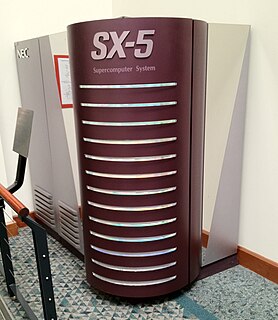
An operating system (OS) is system software that manages computer hardware, software resources, and provides common services for computer programs.

A supercomputer is a computer with a high level of performance as compared to a general-purpose computer. The performance of a supercomputer is commonly measured in floating-point operations per second (FLOPS) instead of million instructions per second (MIPS). Since 2017, there are supercomputers which can perform over a hundred quadrillion FLOPS (petaFLOPS). Since November 2017, all of the world's fastest 500 supercomputers run Linux-based operating systems. Additional research is being conducted in China, the United States, the European Union, Taiwan and Japan to build faster, more powerful and technologically superior exascale supercomputers.
UNICOS is the name of a range of Unix-like operating system variants developed by Cray for its supercomputers. UNICOS is the successor of the Cray Operating System (COS). It provides network clustering and source code compatibility layers for some other Unixes. UNICOS was originally introduced in 1985 with the Cray-2 system and later ported to other Cray models. The original UNICOS was based on UNIX System V Release 2, and had numerous BSD features added to it.

A Beowulf cluster is a computer cluster of what are normally identical, commodity-grade computers networked into a small local area network with libraries and programs installed which allow processing to be shared among them. The result is a high-performance parallel computing cluster from inexpensive personal computer hardware.
Cray Inc., a subsidiary of Hewlett Packard Enterprise, is an American supercomputer manufacturer headquartered in Seattle, Washington. It also manufactures systems for data storage and analytics. Several Cray supercomputer systems are listed in the TOP500, which ranks the most powerful supercomputers in the world.
ETA Systems was a supercomputer company spun off from Control Data Corporation (CDC) in the early 1980s in order to regain a footing in the supercomputer business. They successfully delivered the ETA-10, but lost money continually while doing so. CDC management eventually gave up and folded the company.
The ETA10 is a line of vector supercomputers designed, manufactured, and marketed by ETA Systems, a spin-off division of Control Data Corporation (CDC). The ETA10 was announced in 1986, with the first deliveries made in early 1987. The system was an evolution of the CDC Cyber 205, which can trace its origins back to the CDC STAR-100.

ASCI Red was the first computer built under the Accelerated Strategic Computing Initiative (ASCI), the supercomputing initiative of the United States government created to help the maintenance of the United States nuclear arsenal after the 1992 moratorium on nuclear testing.

NEC SX describes a series of vector supercomputers designed, manufactured, and marketed by NEC. This computer series is notable for providing the first computer to exceed 1 gigaflop, as well as the fastest supercomputer in the world between 1992-1993, and 2002-2004. The current model, as of 2018, is the SX-Aurora TSUBASA.

The NASA Advanced Supercomputing (NAS) Division is located at NASA Ames Research Center, Moffett Field in the heart of Silicon Valley in Mountain View, California. It has been the major supercomputing and modeling and simulation resource for NASA missions in aerodynamics, space exploration, studies in weather patterns and ocean currents, and space shuttle and aircraft design and development for over thirty years.
The Parallel Virtual File System (PVFS) is an open-source parallel file system. A parallel file system is a type of distributed file system that distributes file data across multiple servers and provides for concurrent access by multiple tasks of a parallel application. PVFS was designed for use in large scale cluster computing. PVFS focuses on high performance access to large data sets. It consists of a server process and a client library, both of which are written entirely of user-level code. A Linux kernel module and pvfs-client process allow the file system to be mounted and used with standard utilities. The client library provides for high performance access via the message passing interface (MPI). PVFS is being jointly developed between The Parallel Architecture Research Laboratory at Clemson University and the Mathematics and Computer Science Division at Argonne National Laboratory, and the Ohio Supercomputer Center. PVFS development has been funded by NASA Goddard Space Flight Center, The DOE Office of Science Advanced Scientific Computing Research program, NSF PACI and HECURA programs, and other government and private agencies. PVFS is now known as OrangeFS in its newest development branch.

A computer cluster is a set of loosely or tightly connected computers that work together so that, in many respects, they can be viewed as a single system. Unlike grid computers, computer clusters have each node set to perform the same task, controlled and scheduled by software.
A lightweight kernel (LWK) operating system is one used in a large computer with many processor cores, termed a parallel computer.

The Slurm Workload Manager, or Slurm, is a free and open-source job scheduler for Linux and Unix-like kernels, used by many of the world's supercomputers and computer clusters.
India's Supercomputer Programme was started in late 1980s, precisely during the 3rd quarter of 1987, in New Delhi for Software, in Bangalore for Hardware, and in Pune for Firmware, while Sam Pitroda, Advisor to C-DOT, and C-DOT's Indigenous Architecture and Design Team constituted by its Senior Member Technical Staff / Senior Programme Managers including Mohan C. Subramaniyam alias Mohan Rose Ali, Periasamy Muthiah, and Leslie D'Souza had all worked hard at the Centre for Development of Telematics (C-DOT), after successfully completing their 3 years mission on designing the Nation's first ever indigenous C-DOT Digital Switching System - DSS, to create C-DOT's Indigenous Super-computing Machine called CHIPPS - C-DOT High-Performance Parallel Processing System, because the contracted Cray X-MP Supercomputers were denied for export to India which was under the Statesmanship and Stewardship of Mr. Rajiv Gandhi, the then Prime Minister of India, due to an arms embargo imposed by US on India during Ronald Reagan's Presidential Administration, for it was a dual-use technology and it could be used for developing indigenous Strategic Defense Systems by India.

The main credit to supercomputers goes to the inventor of CDC -6600, Seymour Cray. The history of supercomputing goes back to the early 1920s in the United States with the IBM tabulators at Columbia University and a series of computers at Control Data Corporation (CDC), designed by Seymour Cray to use innovative designs and parallelism to achieve superior computational peak performance. The CDC 6600, released in 1964, is generally considered the first supercomputer. However, some earlier computers were considered supercomputers for their day, such as the 1954 IBM NORC, the 1960 UNIVAC LARC, and the IBM 7030 Stretch and the Atlas, both in 1962.

Approaches to supercomputer architecture have taken dramatic turns since the earliest systems were introduced in the 1960s. Early supercomputer architectures pioneered by Seymour Cray relied on compact innovative designs and local parallelism to achieve superior computational peak performance. However, in time the demand for increased computational power ushered in the age of massively parallel systems.

Compute Node Kernel (CNK) is the node level operating system for the IBM Blue Gene series of supercomputers.

Catamount is an operating system for supercomputers.

The high performance supercomputing program started in mid-to-late 1980s in Pakistan. Supercomputing is a recent area of Computer science in which Pakistan has made progress, driven in part by the growth of the information technology age in the country. Developing on the ingenious supercomputer program started in 1980s when the deployment of the Cray supercomputers was initially denied.















